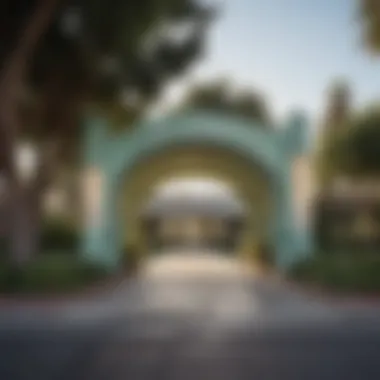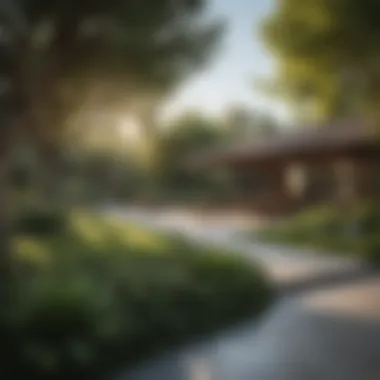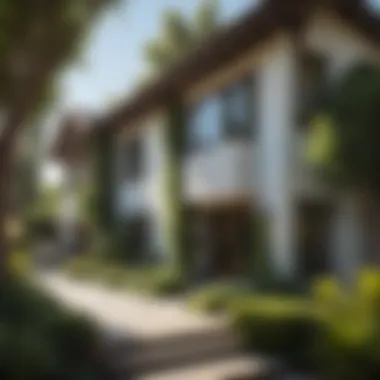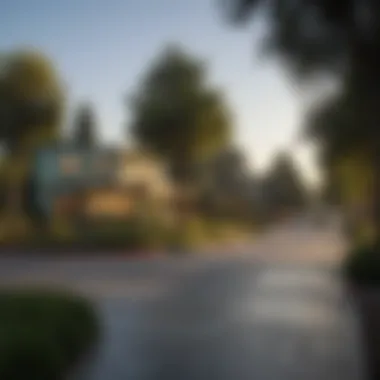Exploring Los Angeles Village Green: Architectural Treasure


Intro
Los Angeles Village Green represents an important chapter in the narrative of mid-century architecture. This densely packed neighborhood serves not only as a series of homes but as a living testament to community living in Los Angeles. The vibrancy of Village Green reflects a synthesis of thoughtful design, historical context, and a commitment to preserving residential culture amid urban evolution. As we dive deep into its architectural significance, we also uncover the sociocultural implications it carries.
Home Features
Architectural Styles
Los Angeles Village Green presents a unique showcase of architectural styles seen mostly in mid-century modern homes. The predominant feature of these homes is their blend of functionality and aesthetics. They employ clean lines, open floor plans, and materials that reflect the natural environment. One can observe a variety of influences within the Village Green, such as:
- Post-and-Beam Construction: This method emphasizes structural framework, often allowing for large open spaces.
- Flat Roofs: Contrasting traditional pitched roofs, flat designs enhance the mid-century aesthetic.
- Natural Materials: Wood and stone emphasize a connection to the landscape, characteristic of the architectural ethos during that era.
This combination creates homes that are not just built structures, but also emphasize harmony with nature.
Interior Design Trends
Inside these homes, the interior design trends align perfectly with the architectural style. Mid-century design honors simplicity and function. Common elements include:
- Open Spaces: These layouts prioritize interaction and family connectivity.
- Functional Furniture: Pieces like the Eames lounge chair exhibit style without compromising utility.
- Bold Colors and Patterns: While elements remain muted, splashes of color with fabrics or artwork create visual interest throughout the space.
These design choices underscore the values of a community focused on modern living while maintaining cultural ties.
"Los Angeles Village Green encapsulates the spirit of mid-century modernism while providing a canvas for everyday life."
Location Highlights
Stunning Natural Landscapes
Located within a vibrant section of Los Angeles, the Village Green community benefits from its proximity to stunning natural landscapes. Nearby parks and green spaces, such as Baldwin Hills Scenic Overlook, provide a serene backdrop and recreational opportunities for residents. The layout of the neighborhood itself encourages outdoor activity, with tree-lined pathways and communal green areas at the heart of the design.
Cultural and Historical Significance
The historical significance of Los Angeles Village Green cannot be overstated. Established in the 1940s, this community reflects a critical period in American history, navigating post-war dynamics and urbanization trends. The Village Green is not just a residential area; it stands as a historical marker of an era that prioritized community and cooperative living in a rapidly changing urban landscape.
The intricate balance between architectural innovation and sociocultural considerations renders this neighborhood a vital case study for urban development enthusiasts, preservation advocates, and real estate professionals.
As we progress through this exploration, a closer look at the transformational journey of Los Angeles Village Green will emerge, revealing the ongoing relevance of its architectural stature within Los Angeles today.
Foreword to Los Angeles Village Green
Los Angeles Village Green represents a unique intersection of architecture, community, and urban culture. As a mid-century development, it offers a glimpse into a period of innovative design and social interaction. This section seeks to illuminate the importance of understanding the nuances and context of this neighborhood, which stands not only as a residential area but also as a symbol of historical and architectural significance.
Exploring the Village Green allows us to appreciate the thought behind the planning and design principles that emphasized communal living. The meticulous integration of attractive landscapes with functional spaces provides a case study for urban planners and architects imagining sustainable living environments today. Moreover, its historical significance reveals how socio-economic contexts shaped community life, reflecting broader trends in Los Angeles as a whole.
A better comprehension of the Village Green enhances our awareness of similar neighborhoods and the evolution of urban settings. Thus, gaining insights from this hidden gem helps real estate enthusiasts and design aficionados to grasp the intricate relationship between architecture and social wellbeing.
Overview of Los Angeles Village Green
Los Angeles Village Green is situated in the Baldwin Hills neighborhood, a fact which positions it within a historically rich area. Constructed in the 1940s, the Village Green was conceived as an innovative residential community. The layout comprises various housing types—primarily two-story garden apartments and townhomes—designed to foster a strong sense of community.
The major highlight of this neighborhood is its spacious lawns and communal gardens that encourage outdoor activities among residents. This design aspect is not just aesthetic; it serves a functional purpose. The Village Green was designed to promote social interaction among neighbors, a crucial factor that enhances the quality of life.
Architects used elements of mid-century modernism in their designs, emphasizing simple lines, open layouts, and integration with nature. This resulted in a unique architectural style that resonates with today’s sustainable design principles, making the Village Green not just a relic of the past but also a beacon for future development.
Significance within Los Angeles


The Village Green holds a special place within the urban landscape of Los Angeles. Its significance lies in its role as a model for post-war suburban development, combining both residential comfort and community cohesion. The neighborhood also reflects broader societal changes, including shifts toward integrated living areas in response to the increasing population during the mid-20th century.
The community's design serves as a counter-narrative to the sprawling developments that define many areas of Los Angeles. Instead of isolation, the Village Green encourages engagement among residents, making it an exception in the city's urban fabric. Furthermore, it stands as an important example of how community-oriented designs can contribute to social wellbeing—a lesson that remains relevant today as urban centers grapple with issues of isolation and urban sprawl.
In essence, Los Angeles Village Green is more than just a housing complex; it embodies a philosophy of living that is still worth exploring. It invites architects, community planners, and residents alike to reflect on the nature of urban living and the potential for creating spaces that are both functional and enriching.
Historical Context
Understanding the historical context of Los Angeles Village Green is essential for grasping its architectural and cultural significance. This unique neighborhood is not merely a collection of homes; it represents a response to the social, economic, and environmental conditions of its time. By examining its origins and evolution, one can appreciate how the Village Green has shaped and been shaped by the broader forces at work in Los Angeles.
Origins and Development Timeline
Los Angeles Village Green was developed in the late 1940s and early 1950s, a period marked by post-war optimism and suburban expansion. The neighborhood emerged as a strategic response to the growing demand for housing following World War II. The vision was to create a community that was not just a living space but also a cohesive unit promoting social interaction and a sense of belonging.
The development began under the guidance of architect and planner Thornton Ladd, who aimed to integrate natural landscapes with residential buildings. This approach featured a design that emphasized green spaces, walkways, and a shared sense of community. By 1950, the first homes were completed, setting the tone for the architectural style that defined the Village Green.
Key milestones in its development include:
- 1946: Initial planning stages begin, focusing on mid-century modern design.
- 1950: First homes constructed, showcasing innovative design principles and materials.
- 1956: The area gains recognition as a model for community living, earning the attention of urban planners and architects across the nation.
Socio-economic Influences
The socio-economic context of the mid-20th century played a significant role in shaping Los Angeles Village Green. This was an era defined by economic growth, demographic shifts, and changing social values. The development was influenced by various factors, including:
- Post-war Economic Boom: The return of servicemen prompted increased demand for housing. This led to the construction of family-oriented neighborhoods, reflecting the aspirations of many American families at the time.
- Cultural Shifts: The mid-century modern movement was not solely an architectural trend but also reflected broader cultural shifts toward informal living and a strong connection with nature. Residential designs prioritized natural light, open spaces, and seamless transitions between indoor and outdoor settings.
- Community Living: The concept of a planned community gained traction. Villages offered not just homes but amenities that fostered social interaction, such as parks and pools. Los Angeles Village Green embodied this idea, combining aesthetic appeal with functional living.
In summary, the historical context of Los Angeles Village Green reveals a rich narrative of innovation amidst changing societal needs. This architectural gem serves as a reminder of the ideals and aspirations that shaped its creation and continues to influence the urban landscape of Los Angeles today.
Architectural Characteristics
The architectural characteristics of Los Angeles Village Green play a crucial role in illustrating its significance. They serve as a testament to the design philosophies of the mid-twentieth century while also reflecting the community's identity. This section discusses essential elements, benefits, and considerations surrounding these architectural features.
Design Principles of Mid-Century Architecture
Mid-century architecture is marked by simplicity and an integration with nature. It emphasizes clean lines, open spaces, and a connection between indoor and outdoor environments. This design style encourages a less ostentatious approach, allowing functionality to take precedence over ornamentation. Natural materials, earthy colors, and large windows are prevalent, ensuring ample light and a seamless flow with the surroundings. Within Los Angeles Village Green, these principles emerge distinctly, showcasing how homes can coexist beautifully with their landscapes.
Key Architectural Features of the Village Green
Landscaping
Landscaping in Los Angeles Village Green is a defining characteristic. It contributes greatly to the overall aesthetic and ambiance. Landscape architects often designed the greenery to promote community interactions and enhance privacy. One key feature is the integrated green spaces, which invite communal gatherings.
The choice of native and drought-resistant plants ensures sustainability. This approach reduces maintenance needs while enhancing the visual appeal. The unique feature of open courtyards is also notable. These areas offer both beauty and utility, creating a calming atmosphere that resonates with residents and visitors alike. However, potential downsides include the ongoing need for upkeep to maintain the desired aesthetics.
Building Materials
The choice of building materials in Los Angeles Village Green underscores durability and thermal efficiency. Common materials include brick, wood, and reinforced concrete. This combination allows for strong structures that can withstand environmental factors. One notable characteristic is the blend of traditional and modern materials, which forge a connection to both history and contemporary design.
This choice is beneficial for energy savings, especially in warmer climates. The integration of insulation materials helps maintain comfortable indoor temperatures while minimizing energy costs for residents. Unique features, like the use of recycled materials in some renovations, further highlight a commitment to sustainability. Nevertheless, some older materials may require more extensive maintenance, posing future challenges for conservation efforts.
Layout and Spacing
The layout and spacing within Los Angeles Village Green are thoughtfully designed to promote a sense of community. Homes are arranged to foster interaction while preserving privacy. The use of cul-de-sacs and pathways encourages social engagement among residents, facilitating a neighborly atmosphere.
Open floor plans are common, allowing flexibility in use. This functional layout is a popular choice for families who desire both space and accessibility. A unique aspect is the thoughtful placement of homes to maximize natural light and cross-ventilation. While this promotes sustainability, it may also lead to concerns about noise if homes are too close together.


Overall, the architectural characteristics of Los Angeles Village Green embody both the aesthetic values of mid-century design and the practical needs of modern living. Their significance in the community's narrative cannot be overstated.
Community Dynamics
Community dynamics play a pivotal role in understanding Los Angeles Village Green. The essence of community is reflected in how residents interact, engage with each other, and contribute to the social fabric of their environment. This section examines two critical components: civic and social engagement, and cultural diversity and cohesion.
Civic and Social Engagement
Civic and social engagement are fundamental to fostering a vibrant community within Los Angeles Village Green. Resident participation in local activities enhances connectivity among neighbors. This active involvement often manifests through neighborhood meetings, workshops, and community events.
Engagement yields multiple benefits:
- Strengthened relationships: A strong sense of trust and cooperation builds over time.
- Shared responsibilities: Residents often share duties in maintaining the quality of their community.
- Awareness of issues: When community members engage, they become informed about local challenges and opportunities.
In particular, Los Angeles Village Green has seen initiatives that encourage participation. Involvement in decision-making processes allows residents to voice their concerns and suggestions for improvements in their neighborhood. This contributes not only to a sense of belonging but also promotes collective stewardship of the area.
Cultural Diversity and Cohesion
Cultural diversity represents a core strength of the Los Angeles Village Green community. The neighborhood consists of a rich tapestry of backgrounds, experiences, and perspectives. This multitude of cultures contributes significantly to the community's identity and cohesion.
The benefits of cultural diversity include:
- Enhanced creativity: Different viewpoints foster innovation in community projects.
- Increased empathy: Interacting with various cultures promotes understanding and tolerance.
- Shared celebrations: Diverse cultural traditions lead to communal celebrations, enriching the neighborhood’s social calendar.
Cohesion is crucial for a community with varied cultural backgrounds. Efforts at integration, including cultural events and educational programs, help bridge gaps among residents. These initiatives create opportunities for dialogue and build connections across different cultural groups.
"Community is much more than a collection of people. It's a rich tapestry of interactions, experiences, and mutual support that enhances the living experience."
Los Angeles Village Green demonstrates that through civic engagement and cultural diversity, a community not only thrives but also retains its historical significance. Engaging diverse voices and perspectives not only adds depth to the community's identity but also lays the groundwork for its future resilience and adaptability.
Preservation and Challenges
Preserving the architectural integrity and social fabric of Los Angeles Village Green is essential for maintaining its significance as a historical and cultural landmark. This unique community reflects mid-century ideals that shaped urban living in the 20th century. As urban landscapes evolve and modern demands arise, the challenges to preservation become more pronounced.
Historic Designation and Conservation Efforts
The first step in preserving Los Angeles Village Green is recognizing its historic value. The neighborhood has received historic designation from various preservation organizations, which often includes guidelines to protect its architecture, landscaping, and community atmosphere. The designation is not just a badge of honor but a tool that ensures compliance with preservation standards.
Conservation efforts include maintaining original structure designs. Many homeowners engage in restoration activities, adhering to guidelines that respect the historical essence of the buildings. Efforts are often supported by local non-profits and heritage organizations, which provide resources and education regarding best practices in preservation.
Preservation work does not come without challenges. Funding for restoration projects is always limited. In some cases, owners expreience financial burdens that can lead to renovations diverging from historical accuracy. When pursuing such work, the delicate balance between modern needs and historical accuracy often comes into discussion.
Contemporary Pressures and Developmental Challenges
The contemporary urban landscape presents numerous pressures on Los Angeles Village Green. As surrounding areas experience rapid development, the increase in property values further strains the community. There is a looming threat of encroaching construction which can dramatically alter the unique environment.
Moreover, the zoning regulations may not always favor preservation efforts. New development trends push for higher density housing and commercial spaces, which clash with the established residential character of the Village Green. This trend poses risks to community cohesion and architectural authenticity.
Additionally, social dynamics play a role in these challenges. As new residents move into the area, the original community bonds may weaken. This can lead to a disconnect between long-time residents who cherish the historical aspect and newcomers who prioritize modern conveniences.
To mitigate these issues, it is crucial for the community to engage in dialogues about their vision for the future. Solutions like establishing preservation zones can help safeguard the architectural landscape. Activism within the community can play a pivotal role in combating potential threats, ensuring that future developments honor the historical significance of Los Angeles Village Green.
"Preservation is the key to maintaining the character and identity of unique neighborhoods like Los Angeles Village Green."
Comparative Analysis


Understanding the Los Angeles Village Green within a comparative framework allows for deeper insights into its architectural and social significance. Comparative analysis in this context not only examines the Village Green itself but also places it alongside other similar communities. This contrast illuminates the unique aspects of Village Green and highlights its contributions to urban planning trends. The exploration of these comparisons can uncover shifts in design philosophy or community organization that reflect broader societal changes.
Similar Communities in Los Angeles
Several neighborhoods in Los Angeles share characteristics akin to the Village Green, inviting a comparative examination. For instance, Claremont, famed for its historic charm, showcases a blend of modernist designs and community-focused layouts. Similarly, the Baldwin Hills Village serves as a significant touchpoint, highlighting the principles of community living within a mid-century context.
- Claremont
- Baldwin Hills Village
- Focus on sustainability and historical preservation
- A mix of modernist and colonial designs
- Strong community ties fostering local events
- Emphasis on self-contained living spaces
- Integration with nature and outdoor areas
- Cultural significance reflective of mid-century values
By studying these neighborhoods, one can appreciate how different urban designs promote social interaction and community building. The neighborhoods illustrate varying approaches to residential planning, prioritizing different aspects like communal spaces or aesthetic values.
Influence on Urban Planning Trends
The existence of the Village Green offers invaluable insights into the evolution of urban planning in Los Angeles. It has had a notable impact on several key trends:
- Increase in Eco-friendly Designs:
The emphasis on integrating nature into living spaces has influenced modern residential projects, pushing for greener architecture. - Community-centric Developments:
Lessons from the design of Village Green underscore the importance of creating spaces that enhance community involvement and interaction. This aspect promotes developments that foster connections among residents. - Mixed-use Planning:
The balance of residential and communal spaces in the Village Green aligns with contemporary urban strategies that seek to minimize urban sprawl and reduce dependence on cars.
Future Prospects
The future of Los Angeles Village Green is pivotal not only for its residents but also for urban planning and architectural integrity in the region. This section analyzes the vision for community development and the engagement of new generations in preserving the unique character of the Village Green. Both aspects highlight how this enclave can evolve while maintaining its historical essence.
Vision for Community Development
As urban centers expand, the importance of preserving mid-century architectural gems like Los Angeles Village Green becomes increasingly significant. A forward-looking vision for its community development focuses on creating inclusive spaces that accommodate both current and future residents. This involves addressing potential housing demands while being sensitive to the architectural legacy of the area.
Key elements of this vision may include:
- Sustainable Design: Integrating green building practices that enhance the environmental quality of the neighborhood can be beneficial. Renewable energy sources and eco-friendly materials should be considered in any future development.
- Mixed-Use Spaces: Encouraging mixed-use developments can foster a thriving community by providing essential services within walking distance. This integration can enhance social ties and reduce dependence on automobiles.
- Public Amenities: The planning of parks, recreational areas, and community centers is crucial. Such spaces can promote social interactions and provide venues for cultural events, enhancing community bonding.
- Transportation Infrastructure: Improving public transport options can facilitate access to other parts of Los Angeles while preserving the pedestrian-friendly character of the Village Green.
These considerations emphasize a balanced approach where development aligns with the neighborhood's history while meeting contemporary needs.
Engagement of New Generations
To ensure the longevity and vitality of Los Angeles Village Green, engaging new generations is crucial. Young residents and newcomers bring fresh perspectives and ideas that can revitalize community initiatives and uphold historical significance. Strategies for engagement might include:
- Educational Programs: Offering workshops and seminars about the architectural history and significance of the Village Green can foster appreciation and respect among younger residents.
- Community Involvement: Encouraging participation in community meetings and decision-making processes allows younger voices to be heard. Involvement can lead to initiatives that reflect the needs and aspirations of all residents.
- Social Media Campaigns: Utilizing platforms like Facebook and Reddit can raise awareness about the Village Green's heritage. Such campaigns can attract interest from individuals who might not otherwise engage with the community.
"Engaging new generations not only preserves a legacy but enriches the community dynamic."
Fostering a sense of ownership among young residents will ensure that the communal spirit of the Village Green thrives. This collaborative approach can cultivate a strong identity and encourage a proactive stance toward both preservation and development.
Closure
The conclusion serves as a crucial part of the article by consolidating the insights gathered throughout the exploration of Los Angeles Village Green. Within this section, specific elements come into focus that highlight the neighborhood's architectural, cultural, and historical impact. By summarizing key points, readers can recollect important takeaways which clarify the role this community plays in the broader context of urban development.
Summary of Key Insights
In reviewing the Los Angeles Village Green, several key insights emerge that encapsulate its significance:
- Architectural Harmony: The design principles of mid-century architecture are harmoniously integrated within the landscape, establishing a unique character of the community.
- Community Engagement: The vibrant social fabric, stemming from diverse cultural backgrounds, fosters a sense of shared identity among residents.
- Preservation Efforts: Ongoing challenges in preservation highlight the struggle between upholding historical value and accommodating modern urban demands.
These insights contribute to a well-rounded understanding of Los Angeles Village Green. They not only underline its standing as a historical landmark but also emphasize its relevance as a living community.
Reflection on Historical Significance
Reflecting on the historical significance of Los Angeles Village Green reveals its multifaceted role within urban development. Originally conceived during a transformative era in American architecture, the village serves as a living gallery of mid-century design and planning. The community's conception was not merely about constructing homes but envisaging a collective lifestyle that embraced both individuality and commonality.
"Los Angeles Village Green illustrates how thoughtful architectural design can enhance community dynamics and well-being."
This realization is essential for current and future generations, as it provides a template for understanding sustainable community-building practices. By preserving its architectural integrity and social essence, Los Angeles Village Green continues to resonate as a source of inspiration and a model for urban planners and architects alike.















